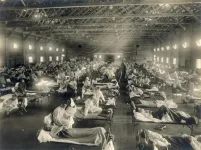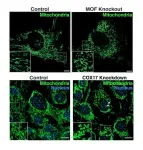(Press-News.org) Hamilton, ON, Oct. 9, 2023 – New analysis of the remains of victims of the 1918 influenza pandemic, which killed an estimated 50 million people worldwide, contradicts the widespread belief the flu disproportionately impacted healthy young adults.
Because so many people fell ill so quickly, physicians at the time believed the healthy were as likely to die from the flu as those who had already been sick or frail. Despite numerous historical accounts, though, it turns out there is no concrete scientific evidence to support that belief.
Researchers at McMaster University and the University of Colorado Boulder who analyzed victims’ age of death and studied lesions on victims’ bones report that the most susceptible to dying of the flu had exhibited signs of previous environmental, social and nutritional stress.
“Our circumstances – social, cultural and immunological – are all intertwined and have always shaped the life and death of people, even in the distant past,” explains Amanda Wissler, an assistant professor in the Department of Anthropology at McMaster and lead author on the study, published today in the journal PNAS.
“We saw this during COVID-19, where our social backgrounds and our cultural backgrounds influenced who was more likely to die, and who was likely to survive,” she says.
Much of the research on the 1918 pandemic relies on historical documentation such as vital statistics, census data and life insurance records, none of which include information on pre-existing conditions, or general environmental, dietary or other chronic stressors which can impact one’s overall health over the course of a lifetime.
For the study, researchers examined the skeletal remains of 369 individuals from the Hamman-Todd Documented skeletal collection, which is housed at the Cleveland Museum of Natural History. All had died between 1910 and 1938. The sample was divided into two groups: a control group who had died before the pandemic, and those who died during the pandemic.
A living person’s skeletal structure may undergo lasting changes due to poor health, resulting in diminished height, irregular growth, developmental tooth defects and other indicators.
The team searched for lesions, or indicators of stress, on the shinbones of the pandemic victims. New bone formation occurs in response to inflammation caused by physical trauma or infection, for example. Researchers can determine if a lesion had been active, in the midst of healing or had completely healed, all of which provide evidence of underlying conditions.
“By comparing who had lesions, and whether these lesions were active or healing at the time of death, we get a picture of what we call frailty, or who is more likely to die. Our study shows that people with these active lesions are the most frail,” says Sharon DeWitte, a biological anthropologist at the University Colorado Boulder and co-author on the study.
Preexisting medical conditions such as asthma or congestive heart failure are common risk factors which can contribute to poor outcomes from infectious diseases such as influenza.
Racism and institutional discrimination can amplify these effects, as evidenced in the COVID-19 pandemic, say researchers. During the Black Death in London, for example, individuals who had previously suffered environmental, nutritional and disease stressors were more likely to die from the plague than their healthier peers.
“The results of our work counter the narrative and the anecdotal accounts of the time,” says Wissler. “This paints a very complicated picture of life and death during the 1918 pandemic.”
The researchers plan to continue to explore the relationship between socioeconomic status and mortality in future work.
Key findings
Contrary to popular belief, there is no evidence the 1918 influenza pandemic disproportionately killed healthy young people.
Remains of victims indicate that, as in other pandemics, pre-existing medical conditions and socioeconomic factors increased likelihood of death from the flu pandemic.
-30-
Media contacts
Matt Innes-Leroux
Leroum2@mcmaster.ca
647-921-5461 (c)
Michelle Donovan
Associate Director, Media Relations
donovam@mcmaster.ca
905-512-8548
Lisa Marshall
Associate Director, Science Storytelling
Office of Strategic Relations and Communications
University of Colorado Boulder
303-492-3115
lisa.marshall@colorado.edu
END
LOS ANGELES — Approximately 7% of Americans have had long COVID, a range of ongoing health problems experienced after infection and recovery from COVID-19. Symptoms can include fatigue, brain fog, headaches, chest pain, heart palpitations and more.
To date, there is no proven treatment for the syndrome, and the mechanisms that cause it are not fully understood.
Now, a new clinical trial from Keck Medicine of USC is investigating if a diet designed to lower inflammation may play a role in easing this often debilitating condition.
The premise of ...
Miriam Merad, M.D., Ph.D., an esteemed immunologist at the Icahn School of Medicine at Mount Sinai, has been elected to the National Academy of Medicine (NAM) in recognition of her pioneering contributions to the fields of immunology and cell biology.
Dr. Merad was elected for her transformational discoveries, establishing for the first time that tissue-resident macrophages have distinct origins, maintain their lineage separately from adult hematopoiesis, and possess unique functions that enhance tissue health, repair, infection defense, and impact tumor outcomes.
She is the Mount Sinai Professor ...
In cases where standard therapies fail, a medication called XEN1101 reduces seizure frequency by more than 50% in some patients and sometimes eliminates them altogether, a new study shows. Unlike several treatments that must be started at low doses and slowly ramped up, the new drug can safety be taken at its most effective dose from the start, the authors say.
Focal seizures, the most common type seen in epilepsy, occur when nerve cells in a particular brain region send out a sudden, excessive burst of electrical signals. Along with seizures, this uncontrolled activity can lead to abnormal behavior, periods of lost awareness, and mood changes. ...
*EMBARGOED UNTIL 11 A.M. MONDAY, OCT. 9*
Liquid biopsies are blood tests that can serially measure circulating tumor DNA (cell-free DNA that is shed into the bloodstream by dying cancer cells). When used in patients with advanced non-small cell lung cancer undergoing immunotherapy, they may identify patients who could benefit from treatment with additional drugs, according to a phase 2 clinical trial in the U.S. and Canada. The trial is led by investigators at the Johns Hopkins Kimmel Cancer Center and its Bloomberg~Kimmel ...
In the game of soccer (association football), goalkeepers have a unique role. To do the job well, they must be ready to make split-second decisions based on incomplete information to stop their opponents from scoring a goal. Now researchers reporting in Current Biology on October 9 have some of the first solid scientific evidence that goalkeepers show fundamental differences in the way they perceive the world and process multi-sensory information.
“Unlike other football players, goalkeepers are required to make thousands of very fast decisions based on limited or incomplete sensory information,” says Michael Quinn, the study’s ...
About The Study: This study of 23,000 individuals found a higher risk of all-cause, cardiovascular disease, and ischemic heart disease mortality among adults with moderate to severe depressive symptoms compared to those without depressive symptoms. Public health efforts to improve awareness and treatment of depression and associated risk factors could support a comprehensive, nationwide strategy to reduce the burden of depression.
Authors: Zefeng Zhang, M.D., Ph.D., of the Centers for Disease Control and Prevention in Atlanta, is the corresponding author.
To access the embargoed study: ...
About The Study: During the first full calendar year of the pandemic, approximately 1 in 5 adolescents had major depressive disorder, and less than half of adolescents who needed treatment had any mental health treatment, according to this analysis of nationally representative survey data of 10,000 U.S. adolescents. Adolescents in racial and ethnic minority groups, particularly Latinx, experienced the lowest treatment rates.
Authors: Michael William Flores, Ph.D., M.P.H., of the Cambridge Health Alliance in Cambridge, Massachusetts, is the corresponding author.
To access ...
A new, bio-inspired drug restores the effectiveness of immune cells in fighting cancer, a team led by researchers at The University of Texas at Austin has found. In mouse models of melanoma, bladder cancer, leukemia and colon cancer, the drug slows the growth of tumors, extends lifespan and boosts the efficacy of immunotherapy. The research is published in the journal Cancer Cell and could be a game changer for many cancer patients.
Many cancers delete a stretch of DNA called 9p21, which is the most common deletion across all cancers, occurring in 25%-50% of certain cancers such as melanoma, bladder ...
A new combination of treatments safely decreased growth of pancreatic cancer in mice by preventing cancer cells from scavenging for fuel, a new study finds.
Led by researchers at NYU Grossman School of Medicine, its Department of Radiation Oncology, and the Perlmutter Cancer Center, the work builds on prior discoveries at NYU Langone that revealed how pancreatic cancer cells, to avert starvation and keep growing, find alternate fuel sources. Normally supplied by the bloodstream, oxygen, blood sugar, and other resources become scarce as the increasing density of fast-growing pancreatic tumors cuts off their own blood supply. ...
The intricate control of cellular metabolism relies on the coordinated and harmonious interplay between the nucleus and mitochondria. On the one hand, mitochondria are the hub for the production of essential metabolites, which aside from being required to meet the energy demands of the cell, also serve as the building blocks for constructing both genetic and epigenetic landscapes in the nucleus. On the other hand, the majority of mitochondrial metabolic enzymes are encoded by the nuclear genome, making the function of these two organelles highly interdependent on one another. Inter-organellar communication is aided by molecules that shuttle between these two compartments. ...




